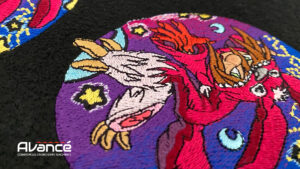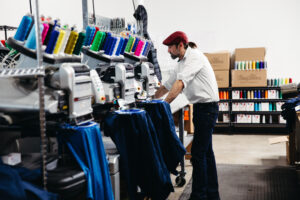Seemingly ubiquitous as a cliché (e.g., the dawn of time), embroidery possesses a rich, ancient-like history. A timeless classic, the art can be traced back to the Cro-Magnon days, roughly around 30,000 B.C. Derived from the French term broderie, meaning embellishment, the art of embroidery has indeed been embellished with practice, perfected and then perfected some more, passing down from generation to generation. Today’s artform, however, has shifted from the days of old, morphing into big business courtesy of technology. In 2022 alone, the global embroidery market hit an all-time high at $2.7 billion and is expected to reach $5.7 billion over the next five years.
All that being said, how does one tap into such a vast, historical market? How does a novice become an expert? Aside from soaking in the beautiful annals of embroidery, exactly what else is vital to a decorator’s success?
A Starting Point
The first step any newbie interested in embroidery needs to take is answering one, simple question: Who are you embroidering for?
Whether embroidering is a newfound hobby, a side hustle or a full-time career, identifying your target audience or market is crucial to the trajectory of your embroidery journey. Every industry expert, from small-business owners to international corporate managers, agrees it is just as important to learn as much as possible about who exactly it is your working for as it is to learn the logistics of embroidery itself.
“Once you identify your audience and better understand them, you can consider what kind of garments you want to decorate,” says Kyle Jones of Ricoma Intl. Corp. “From there, you can find the perfect embroidery machine.”
Beyond that, finding the perfect machine will come down to each individual embroiderer’s specific goals and needs.

You can achieve sharp detailing with Coldesi’s Avancé lineup. Photo courtesy of ColDesi
Consistent practice does lend itself to perfection, so naturally operating any embroidery machine will manifest teachable experience. However, there are some limitations that are immediately difficult to deal with as far as your initial equipment. Prosumer embroidery machines, for example, may have become more capable in recent years; nevertheless, they still lag behind comparable commercial machinery.
“In the hobbyist space, the first restriction that causes difficulty is the decoration area, followed immediately by having multi-needle capability to prevent the incredibly time-consuming process of manually changing colors,” says veteran commercial embroiderer and industry consultant Erich Campbell. “No matter your eventual goal with embroidery, I would recommend getting the largest embroidery area you can reasonably afford and that anyone planning on a commercial venture strongly consider a multi-needle, tubular machine even as an entry point.”
Once an intended customer base has been established, understanding the types of garments and treatments clients will require makes a difference to the machine and accessories you source to fulfill their needs. Focus on a niche that you are knowledgeable and passionate about says Holly Wood, a ColDesi product manager. Keeping your niche centered is a great avenue she says, but also, “don’t forget about who you know. Every person you know is a potential customer.” Fleshing out a business concept, which includes your ideal customer base and potential offerings, will prompt more intelligent questions for vendors.
“Ultimately, there are many ways to outfit an embroidery shop, and even larger professional organizations may elect to use prosumer level equipment when portability is more important than speed. Machines and brands are not necessarily better or worse, so much as more or less fit for your situation in many cases,” Campbell explains.
“When all other things are equal, you may find a choice between brands or vendors is better made on who will be able to service your machine technically with the greatest ease and the lowest total cost,” Campbell adds. “Remember, the cost of owning a machine goes far beyond the initial purchase.”
With this in mind, plan ahead and choose a product you can grow into. As Jones warns, many newbies tend to underbuy when they are first starting out, a maneuver aimed at mitigating risks. However, he says, they soon discover the demand can quickly grow beyond the capabilities of their first machine, and as such must invest in a new one.
Single or Multi? Oh My!
Speaking of investments, when it comes to embroidery machines, the sheer number of products available can be overwhelming, especially if you are unsure which type of tech will deliver you your greatest return. Once your customer baseline has been established, diligent machine research is the definitive next step.
To avoid a battle of the needles, it is vital to have a thorough understanding of each machine category. Only then will you be ready for head-to-head embroidery combat.

Ricoma’s MT-1502 is a two-head commercial machine that can embroider on both small and bulky items. Photo courtesy of Ricoma
According to Jones, single-needle embroidery machines are typically a combo of embroidery and sewing machines that can be found in most craft- and big-box stores. They are affordable, with costs ranging from a few hundred to a few thousand dollars. Ideal for beginners, hobbyists, or crafters sewing or embroidering simple designs featuring a small color palette. As convenient and readily available as they are, though, single-needle machines aren’t typically used for commercial embroidery businesses.
Joshua Parr, a Melco applications engineer, agrees, emphasizing it all depends on the application. “Single-needle machines are great for the hobbyist with a small amount of embroidery needs and can generally get the job done, one color-at-a-time.”
“Single needle machines are largely only seen in the craft world short of some very particular usage in personalization,” Campbell says. “In any commercial production, a multi-needle machine is going to become a must, both for the needs of more complicated multicolored embroidery, and for production friendliness when using multiple types of thread.”
Multi-needle machines up the ante. Usually consisting of four to 15 needles, these machines can cost anywhere between $7,000 and $19,000. “Multi-needle machines provide faster production speeds and are better suited to those wanting quicker color changes with multicolored designs,” Parr says. “Single-head machines sew one-at-a-time. Alternatively, multi-head machines give you leverage over production output per hour. These days, linking multiple single-head machines is a flexible way to expand your business as your production needs grow—a flexibility Melco’s modular system provides. If one machine experiences a thread break, the other linked machines continue sewing. This keeps your production moving forward.”
Another big separation in terms of machine types is between fully craft-styled flatbed machines and the prosumer tubular machines, Campbell says. “Tubular machines allow for the cylinder arm to reach inside of a garment for much easier placement on finished pieces, whereas a flatbed machine requires you to wrangle the rest of the garment out of the way from beneath the hoop. This isn’t impossible, but it adds difficulty.”
In the realm of commercial, multi-needle tubular machines, the next natural step up is from a single-head to a multi-head system. According to Campbell, every shop should start with a single-head machine and then keep it, even after your shop starts acquiring multi-head systems. The reason for this is single-head machines work for easy sampling and personalization.
“Multi-head machines are primarily for larger runs of identical designs without any individual personalization,” Campbell says. In addition, he notes: “If you have larger throughput but frequently receive small orders or individualized, personalized pieces, you may find that a fleet of single-head machines is a better buy for the sake of your production day.”
ColDesi’s Wood agrees. “There are strengths and weaknesses of both, you cannot go wrong starting with a single-head and figuring out which type of machine would fit best with your business model as you continue to grow,” she says.
Leveling Up
Assuming you have the necessary gear in place, the recipe for taking an established embroidery business to the next level requires a few key ingredients. It is not only about understanding embroidery basics and the technical differences in machinery but considering your customers’ goals.
“The unsung hero of expansion and growth is simultaneously understanding current clients and profiling potential customers,” says Campbell. “Though it’s easy to point people toward outside technical training, more intricate decoration or even additional equipment, the most important move is to identify a customer who has a need or desire you can personally fulfill with embroidery.”
Gaining insight to underserved markets is a great place to start niche marketing efforts, Campbells says, adding: “Additional training and equipment always are in order, but there’s no reason to equip yourself to create a product you don’t know to whom you are selling. Nurture your overall business plan and increase your ability to service customers that you have already identified.”

Proper training can keep production with multiple machines on track. Photo courtesy of Melco
Along these same lines, Wood emphasizes the importance of salesmanship when marketing your business within your niche and network of contacts. During the sales process with the vendor, inquire about marketing material: contacts for accessories, supplies, wholesale apparel and non-wearables; podcasts; training courses; and even graphics services that aid digitizing efforts. “Training and support need to be deeper than just the machine—partner with a company that is interested in your ongoing success more than just selling you a piece of equipment,” Wood says.
Meanwhile, on your own shop floor, Melco’s Parr recommends investing in your employees as well. As an example, Parr says, taking the time to cross train employees will undoubtedly benefit your customer agenda. “Once your team has solid customer service down, kick it up a notch with continued training on advanced decoration techniques,” Parr explains. “Maybe it’s time to try out puff embroidery on caps or go for a full-front appliqué? Spend a little time to see what your customers’ needs are then figure out how to incorporate them.”
And if those needs guide you into the land of multimedia, investing in a printing system like heat-transfer or direct-to-film (DTF) will allow you to transform your business into a one-stop custom apparel shop, so be it.
“The more you train, the more comfortable and confident you will be. Not only that, but you’ll also be able to broaden your skill set and expand your product line,” Ricoma’s Jones says. “Besides machinery, you can also expand your business by ramping up your marketing efforts with organic and paid advertisements on Google and social media…turning your business into a one-stop shop for embroidery and printing will make your business more convenient and appealing to your customers giving you a leg up on your competition.”





